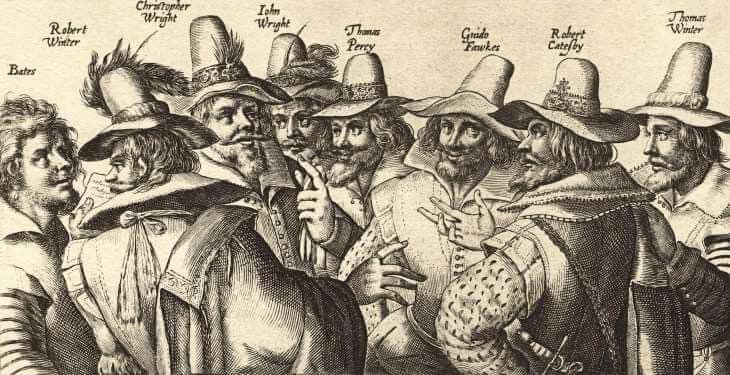|
On November 5, 1605, Guy Fawkes and a group of radical English Catholics tried to assassinate King James I by blowing up Parliament's House of Lords. The plot went badly wrong and all of the conspirators were executed. Soon after, Britons began to celebrate Fawkes' demise and the survival of their king by burning effigies, lighting bonfires and setting off fireworks—a tradition which has continued to this day.

Catholicism in England was heavily repressed under Queen Elizabeth I, particularly after the pope excommunicated her in 1570. During her reign, dozens of priests were put to death, and Catholics could not even legally celebrate Mass or be married according to their own rites. As a result, many Catholics had high hopes when King James I took the throne upon Elizabeth’s death in 1603. James’ wife, Anne, is believed to have previously converted to Catholicism, and his mother, Mary Queen of Scots, was Elizabeth’s Catholic arch-rival prior to being executed. There were even rumours, inspired by his diplomatic overtures to the pope, that James himself would become Catholic.
It soon became clear, however, that James did not support religious tolerance for Catholics. In 1604 he publicly condemned Catholicism as a superstition, ordered all Catholic priests to leave England and expressed concern that the number of Catholics was increasing. He also largely continued with the repressive policies of his predecessor, such as fines for those refusing to attend Protestant services.
The Pocklington area was a renowned Catholic stronghold. Sir Robert Dolman, of Pocklington was knighted by James I in 1604 but later had some of his lands confiscated by the crown as punishment for his Catholic recusancy.
Ursula Rudston was born in 1541 in Hayton, daughter of Nicholas and Jane. Nicholas Rudston had participated in the Catholic uprising ‘The Pilgrimage of Grace’ in 1536. Ursula married Robert Wright of Plowland Hall in Holderness, and fathered the gunpowder plotters John and Christopher Wright, and their sister Martha who married another plotter Thomas Percy. Thomas Percy attended Beverley Grammar School and later Cambridge University.
John and Christopher both attended St. Peter’s school in York along with Guy Fawkes and all three became lifelong friends of strong Catholic faith. The brothers, along with others including Guy Fawkes and Thomas Percy, went on to plan the famous plot to blow up the Houses of Parliament in 1605.
Ursula was incarcerated for a total of 14 years, chiefly in Hull prison with a number of other recusant wives including one of her Babthorpe cousins, and Alice Oldcorne, a relative of the Jesuit Father Edward Oldcorne. It is said that "the courage and cheerfulness of this forceful old lady provided great moral uplift for the other prisoners”. Her incarceration and the sense of injustice felt by the family was probably a factor which helped radicalise her sons.
Nicholas Rudston was succeeded by his second son, John, who married Margaret, daughter of Thomas Trollop of Thornley in Durham, another prominent Catholic, who also suffered imprisonment for 'recusancy'. Trollop sheltered several priests and narrowly escaped execution on the orders of Elizabeth's ruthless Chancellor, William Cecil, Lord Burghley.
The Wright brothers both died when Holbeche House, Staffordshire, was stormed by government forces after the discovery of the plot. Thomas Percy was shot and buried only later to be exhumed along with Catesby and their heads displayed on a pike. Guy Fawkes, along with three others were taken from the Tower of London and executed on 31st January 1606. Fawkes was hung drawn and quartered and his body parts were then distributed to "the four corners of the kingdom", to be displayed as a warning to other would-be traitors.
The 5th November has variously been called Guy Fawkes Night, and Bonfire Night. Bonfires were accompanied by fireworks from the 1650s onwards, and it became the custom after 1673 to burn an effigy (sometimes of the pope). But most modern effigies are of Fawkes. The "guy" is normally created by children from old clothes, newspapers, and a mask, and placed on top of the bonfire.
|

